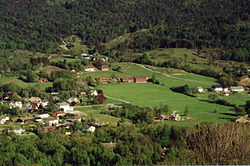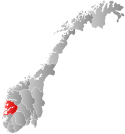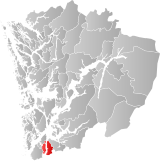Vikebygd (municipality)
Vikebygd Municipality
Vikebygd herad | |
|---|---|
 View of the village of Vikebygd | |
 Hordaland within Norway | |
 Vikebygd within Hordaland | |
| Coordinates: 59°35′39″N 05°35′14″E / 59.59417°N 5.58722°E | |
| Country | Norway |
| County | Hordaland |
| District | Sunnhordland |
| Established | 1 Jan 1902 |
| • Preceded by | Sveen Municipality |
| Disestablished | 1 Jan 1964 |
| • Succeeded by | Ølen and Sveio municipalities |
| Administrative centre | Vikebygd |
| Area (upon dissolution) | |
• Total | 102 km2 (39 sq mi) |
| Population (1963) | |
• Total | 1,049 |
| • Density | 10/km2 (27/sq mi) |
| Time zone | UTC+01:00 (CET) |
| • Summer (DST) | UTC+02:00 (CEST) |
| ISO 3166 code | NO-1215[1] |
Vikebygd is a former municipality in the old Hordaland county, Norway. The municipality existed from 1902 until its dissolution in 1964. It was located along the eastern and western shores of the Ålfjorden, a small branch off the main Hardangerfjorden. The 102-square-kilometre (39 sq mi) municipality is located in the present-day municipalities of Sveio (in Hordaland county) and in Vindafjord (in Rogaland county). The administrative centre of the municipality was the village of Vikebygd, where Vikebygd Church is located.[2]
History
[edit]Historically, the parish of Vikebygd was a part of the old municipality of Fjeldberg. In 1865, Vikebygd parish became a part of the new municipality of Sveen. On 1 January 1902, the eastern part of the municipality of Sveen was separated to form the new municipality of Vikebygd. Initially, Vikebygd had a population of 1,092.[3]
During the 1960s, there were many municipal mergers across Norway due to the work of the Schei Committee. On 1 January 1964, the municipality of Vikebygd was dissolved. Using Ålfjorden as a dividing line the western part of Vikebygd (population: 471) was merged into the neighboring municipality of Sveio and the eastern part (population: 578) was merged into the neighboring municipality of Ølen. On 1 January 2006, all of Ølen municipality was incorporated into Vindafjord municipality in Rogaland county.[3]
Name
[edit]The municipality (originally the parish) is named after the old Vik farm (Old Norse: Víkr). The first element is the plural genitive case vík which means "bay" or "cove". The last element was added as a suffix. It comes from the word byggð which means "settlement" or "inhabited area".[4]
Government
[edit]During its existence, this municipality was governed by a municipal council of directly elected representatives. The mayor was indirectly elected by a vote of the municipal council.[5]
Municipal council
[edit]The municipal council (Heradsstyre) of Vikebygd was made up of 17 representatives who were elected to four year terms. The party breakdown of the final municipal council was as follows:
| Party name (in Nynorsk) | Number of representatives | |
|---|---|---|
| Labour Party (Arbeidarpartiet) | 2 | |
| Local List(s) (Lokale lister) | 15 | |
| Total number of members: | 17 | |
| Party name (in Nynorsk) | Number of representatives | |
|---|---|---|
| Labour Party (Arbeidarpartiet) | 3 | |
| Local List(s) (Lokale lister) | 14 | |
| Total number of members: | 17 | |
| Party name (in Nynorsk) | Number of representatives | |
|---|---|---|
| Labour Party (Arbeidarpartiet) | 2 | |
| Local List(s) (Lokale lister) | 14 | |
| Total number of members: | 16 | |
| Party name (in Nynorsk) | Number of representatives | |
|---|---|---|
| Labour Party (Arbeidarpartiet) | 2 | |
| Local List(s) (Lokale lister) | 14 | |
| Total number of members: | 16 | |
| Party name (in Nynorsk) | Number of representatives | |
|---|---|---|
| Labour Party (Arbeidarpartiet) | 3 | |
| Local List(s) (Lokale lister) | 13 | |
| Total number of members: | 16 | |
| Party name (in Nynorsk) | Number of representatives | |
|---|---|---|
| Labour Party (Arbeidarpartiet) | 1 | |
| Local List(s) (Lokale lister) | 15 | |
| Total number of members: | 16 | |
| Note: Due to the German occupation of Norway during World War II, no elections were held for new municipal councils until after the war ended in 1945. | ||
See also
[edit]References
[edit]- ^ Bolstad, Erik; Thorsnæs, Geir, eds. (26 January 2023). "Kommunenummer". Store norske leksikon (in Norwegian). Kunnskapsforlaget.
- ^ Store norske leksikon. "Vikebygd" (in Norwegian). Retrieved 5 March 2015.
- ^ a b Jukvam, Dag (1999). Historisk oversikt over endringer i kommune- og fylkesinndelingen (PDF) (in Norwegian). Statistisk sentralbyrå. ISBN 9788253746845.
- ^ Rygh, Oluf (1910). Norske gaardnavne: Søndre Bergenhus amt (in Norwegian) (11 ed.). Kristiania, Norge: W. C. Fabritius & sønners bogtrikkeri. p. 100.
- ^ Hansen, Tore; Vabo, Signy Irene, eds. (20 September 2022). "kommunestyre". Store norske leksikon (in Norwegian). Kunnskapsforlaget. Retrieved 1 January 2023.
- ^ "Kommunevalgene og Ordførervalgene 1959" (PDF) (in Norwegian). Oslo: Statistisk sentralbyrå. 1960. Retrieved 15 February 2020.
- ^ "Kommunevalgene og Ordførervalgene 1955" (PDF) (in Norwegian). Oslo: Statistisk sentralbyrå. 1957. Retrieved 15 February 2020.
- ^ "Kommunevalgene og Ordførervalgene 1951" (PDF) (in Norwegian). Oslo: Statistisk sentralbyrå. 1952. Retrieved 15 February 2020.
- ^ "Kommunevalgene og Ordførervalgene 1947" (PDF) (in Norwegian). Oslo: Statistisk sentralbyrå. 1948. Retrieved 15 February 2020.
- ^ "Kommunevalgene og Ordførervalgene 1945" (PDF) (in Norwegian). Oslo: Statistisk sentralbyrå. 1947. Retrieved 15 February 2020.
- ^ "Kommunevalgene og Ordførervalgene 1937" (PDF) (in Norwegian). Oslo: Statistisk sentralbyrå. 1938. Retrieved 16 May 2020.

